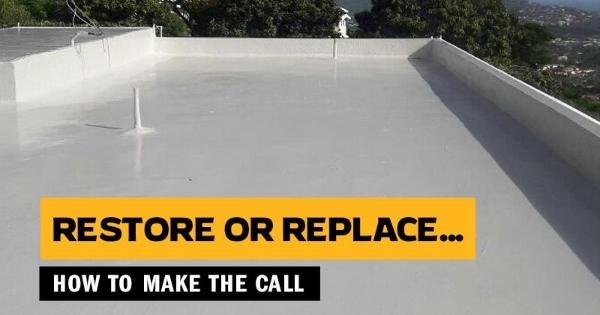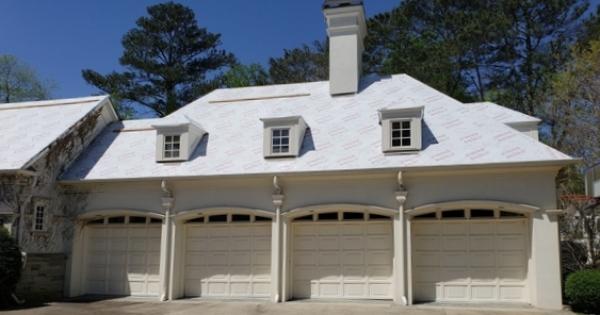Why Replace Your Roof When it Could be Restored?

By Dan White and John Walker, APOC.
Rather than resorting to a complete roof replacement, consider the cost-effective option of restoring a roof instead.
Although it may seem like a complete roof replacement is the best option for an older roof, it isn’t the only choice out there. Rather than spending more money than necessary, restoring a roof is also a viable alternative. Modern roof restoration methods can offer similar results to a complete replacement and it can also save owners and contractors time and money.
Today’s bituminous roofs are ideal for repair because original waterproofing bitumen is easily bonded to new modified repair mastics and coating materials. Additionally, standardized repair procedures have been perfected — following established best practices can return an original roof back to peak performance. However, replacement may be a necessity in certain situations, depending on the overall condition of the roof.
So, how to tell if a roof is a good or bad candidate for restoration? Here’s how to uncover whether or not restoration is a good option or if replacement will be necessary:
Assess the state of your roof
A thorough assessment of your roof will give you a good idea of where to begin with your repair plan.
First, visually inspect the roof for flaws. Initially, this will involve clearing off any trash or accumulated debris that might inhibit a complete visual inspection. Fully vacuuming dirt and gravel from the roof’s surface will grant an even clearer picture. From there, some clues may become easily apparent to the naked eye:
-
A soft area underfoot is an indicator of saturated insulation.
-
Rusted, rotted or cracked decking can sometimes be seen from the inside of the building and may help locate the worst areas of deck deterioration.
-
Ponding water could indicate structural sagging in the deck.
-
A splitting membrane may be visible to the naked eye for experienced professionals.
To gain a more thorough assessment of wet insulation, infrared photography can be deployed to uncover what the naked eye can’t. Small, hand-held infrared cameras are great for smaller roofs. For very large roofs, aerial infrared photography, when possible, can be effective.
Once your visual inspection is complete, drawing up a detailed roof plan is a good next step. GPS systems can speed up this process, especially if you’re drawing plans for very large facilities or complexes. Instruments commonly used in the surveying industry can be used to pinpoint roof equipment and leaking areas.
With your visual inspection complete and a roof plan in hand, you can verify your visual findings through a series of testing. A peel adhesion test can help determine the viability of coating solutions. Core cutting, while destructive, can be eye opening, helping to validate the visual moisture survey and helping to confirm how many layers of roofing actually exist. Wind uplift testing can be used to determine the state of the membrane — remember that membranes can become decimated by a storm, but may stay in place. The next big one can finish the job by ripping the membrane completely off the structure.
Finally, a licensed structural engineer should be retained if there is any evidence of structural failure or additional loading on the roof (condensing units, blowers, metal screens, ballasted antennas, etc.).
Analyzing your findings
With your roof inspection complete, it’s time to determine a path forward. Roofs with low to moderate damage and saturation levels are often good candidates for roof restoration rather than a full re-cover, and can be a cost-effective option when the circumstances call for it. Reroofs will be required in more extreme scenarios, with elevated levels of insulation saturation, decking deterioration and more. A good rule of thumb to remember is that any roof that is more than 20% saturated is deemed a full tear-off, per many national building codes and standards.
In addition to the level of damage uncovered during inspection, there are some additional considerations that should be made when determining the right repair technique for your project. Some of those include:
What is the anticipated life span of the building?
Not every structure merits the same level of repair work. A small retail store that sits in the path of a proposed freeway expansion, for example, might not need a repair that ensures 20 years of performance. A major museum in the hub of a cultural district, by contrast, will require a long-term solution. In either case, proven repair solutions are available to best suit the needs of the given situation.
Are there plans to expand the building in the near future?
It’s generally more economical to reroof a structure in conjunction with an expansion rather than split the project across multiple years. The need for roof access and impact to building operations can be greatly reduced if both projects can be performed at the same time.
Where and at what time of year will the work be done?
A 30-story condo tower in Florida has very different wind, thermal shock, thermal bridging and UV exposure than a single-story industrial plant in the Midwest. These types of conditions should be considered when developing a repair or replacement plan.
The case for restoration
Your determination of the right repair method will depend on the specific circumstances of the job at hand. In situations where restoration is appropriate, you’ll find some significant advantages versus reroofing or other alternative repair measures.
Restoration generally requires far less specialized equipment and does not leave the building interior exposed while the job takes place. A good roof restoration process involves removing any debris and cleaning the roof to prepare for the rest of the project. Next, depending on the condition of the roof, a primer is applied to ensure good adhesion for patching, stain blocking and rust inhibition. Then, patching is performed to make sure all parts of the roof system are watertight. Finally, protective coatings can be applied to ensure long-lasting performance. All the while, regular activity inside the building can continue uninterrupted.
Restoration jobs can also happen far faster than an entire reroof. For contractors, time is money. If you can successfully bring an existing roof back up to its original performance level with restoration methods, you can move on to your next job more quickly.
A restoration project can be undertaken with the purchase of just a few high-performance products, a far more cost-effective solution than replacing the roof entirely. Full restorations on average range between $400 to $700 per square while tear-off and replacement starts at $1,000 per square and can go up from there depending on region and project complexity.
For a restoration project to meet its full potential, you can also work with the trusted supplier of high-performance coatings and mastics to help ensure a job well done. Modern mastic formulations are able to deliver outstanding performance that building owners can rely on for the long term. The right supplier may also be able to help you ensure best practices are followed on your next job, leading to more satisfied customers.
Interested in learning more about roof restoration? Contact the APOC team.
Have a question? AskARoofer.
Find your local roofing contractor in the RoofersCoffeeShop® Contractor Directory.
Original article source: ICP Group













Comments
Leave a Reply
Have an account? Login to leave a comment!
Sign In